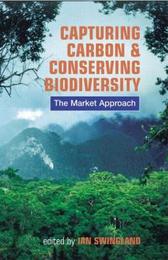
|
Capturing Carbon and Conserving Biodiversity: The Market Approach
Paperback
Main Details
| Title |
Capturing Carbon and Conserving Biodiversity: The Market Approach
|
| Authors and Contributors |
Edited by Ian R. Swingland
|
| Physical Properties |
| Format:Paperback | | Pages:368 | | Dimensions(mm): Height 234,Width 156 |
|
| Category/Genre | Applied ecology
Conservation of the environment |
|---|
| ISBN/Barcode |
9781853839511
|
| Classifications | Dewey:333.72 |
|---|
| Audience | | Undergraduate | | Postgraduate, Research & Scholarly | | Professional & Vocational | |
|---|
| Illustrations |
Figures, tables, bibliography, index
|
|
Publishing Details |
| Publisher |
Taylor & Francis Ltd
|
| Imprint |
Earthscan Ltd
|
| Publication Date |
1 May 2003 |
| Publication Country |
United Kingdom
|
Description
For decades conservation has been based on the donor-driven principle. It hasn't worked. For centuries, environmental pollution or degradation has been addressed by the same attitude: the 'Polluter Pays' principle. That hasn't worked either. The cycle has to stop. But while everyone talks about using a market-driven approach, few know how to do it. Faced with the situation on the ground what do you do? What is happening? How can you engage a system so that it is self-sustaining and the people self-motivated? This study explores how the growing market in carbon can help to conserve carbon-based life forms. It discusses how reducing global warming and saving biodiversity can both be achieved with the right market conditions. The contributors include conservation biologists, ecologists, biologists, economists, lawyers, community and tribal specialists, financial specialists, market makers, environment specialists, climatologists, resource managers, atmospheric scientists, project developers and corporate fund managers.
Author Biography
The editor, Ian R. Swingland, is Emeritus professor of Conservation Biology at the Durrell Institute of Conservation and Ecology (DICE), and Director of Sustainable Forestry Management Ltd
Reviews'Mr Swingland and his co-authors make a compelling case that the best way to reduce the risk of any potential eco-disaster is to embrace market greenery.' The Economist 'This book should be useful for those involved with policy, research, practical conservation or the business development of carbon markets.' Environment Business Magazine 'This set of updated essays is a welcome addition.' The Times Higher
|